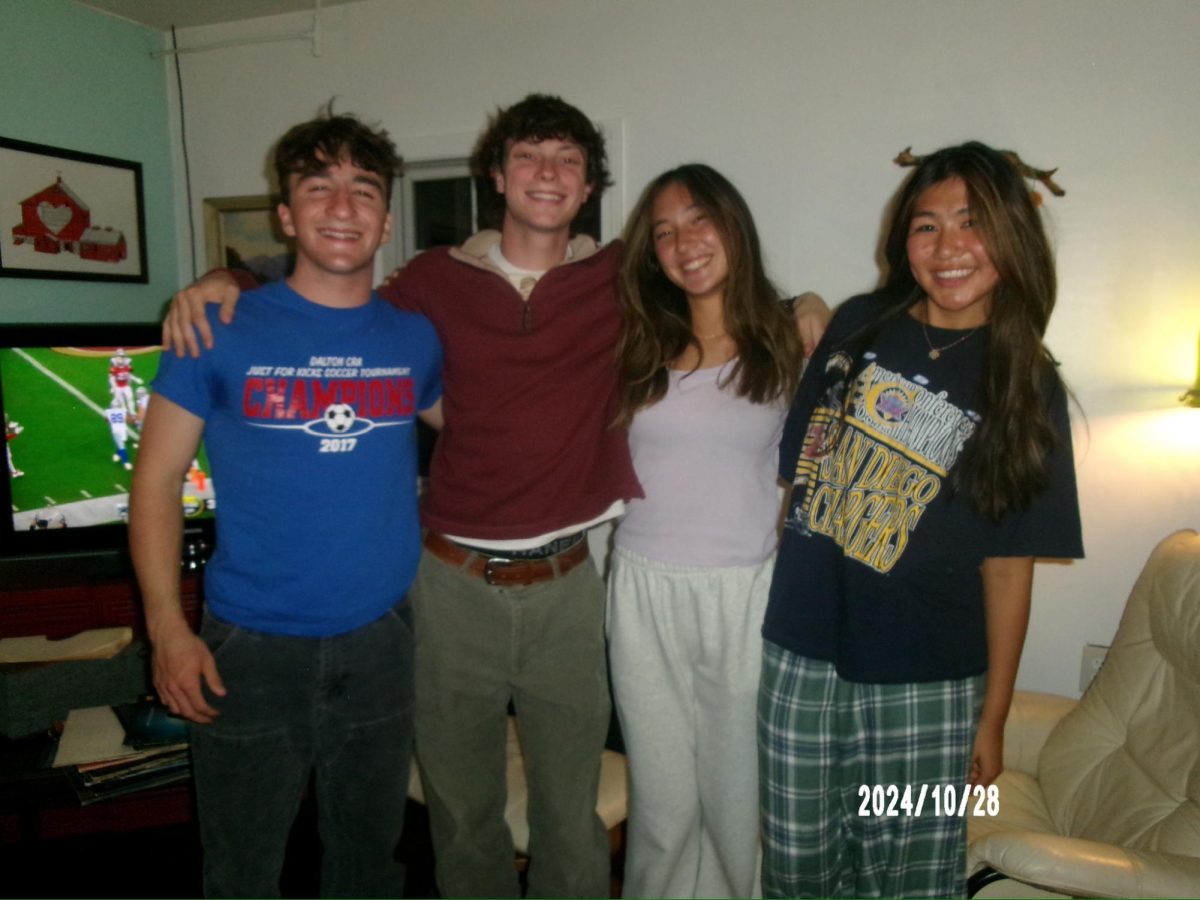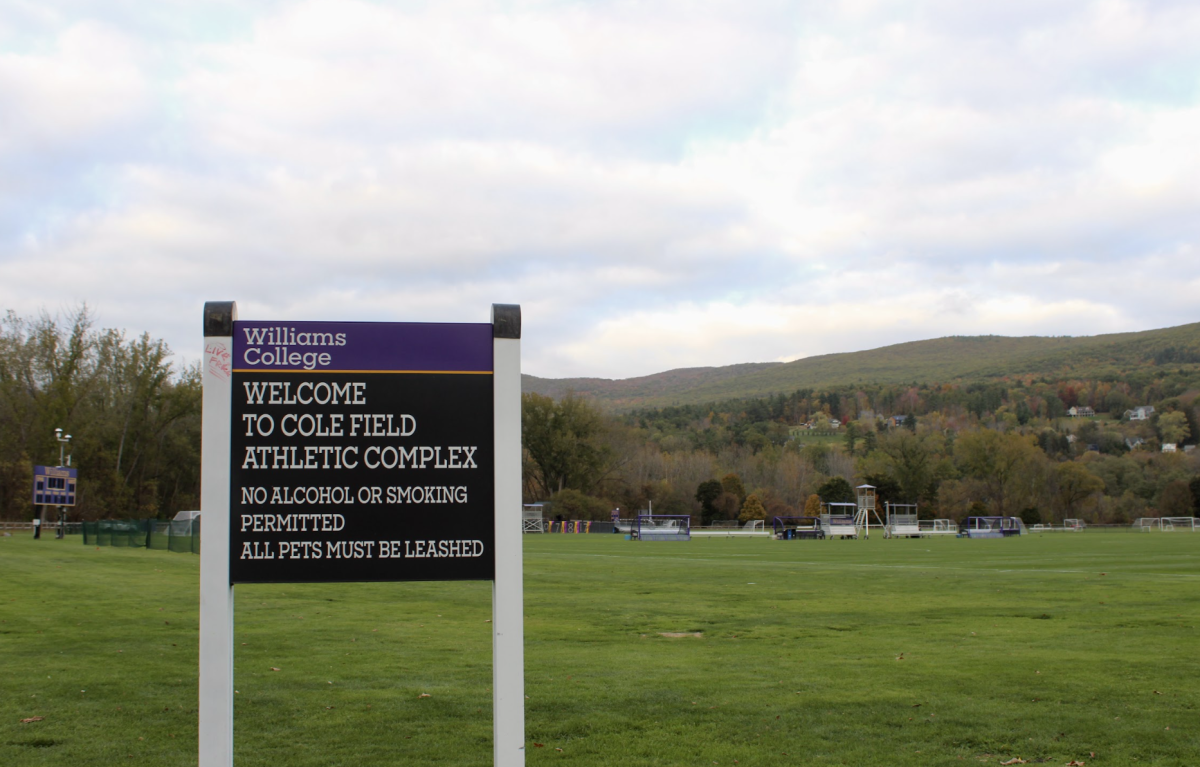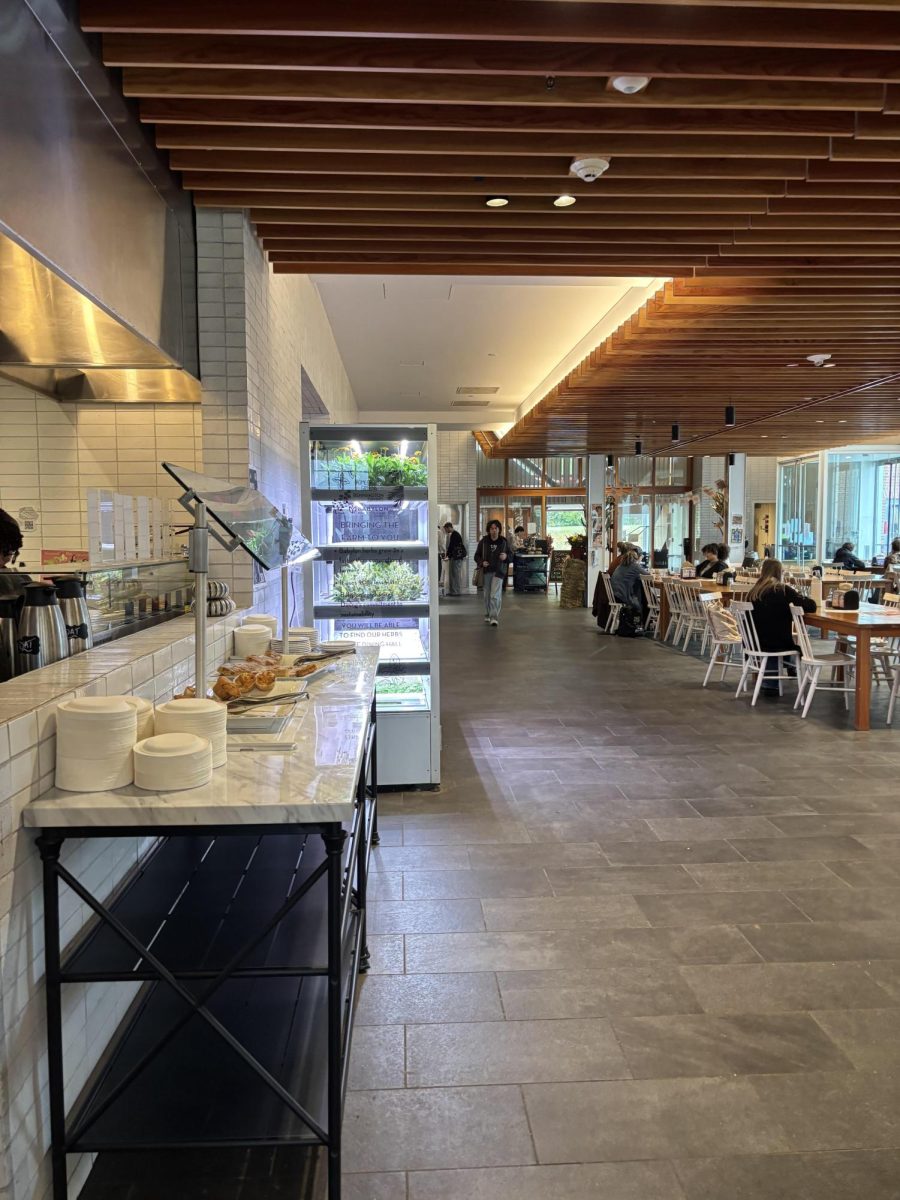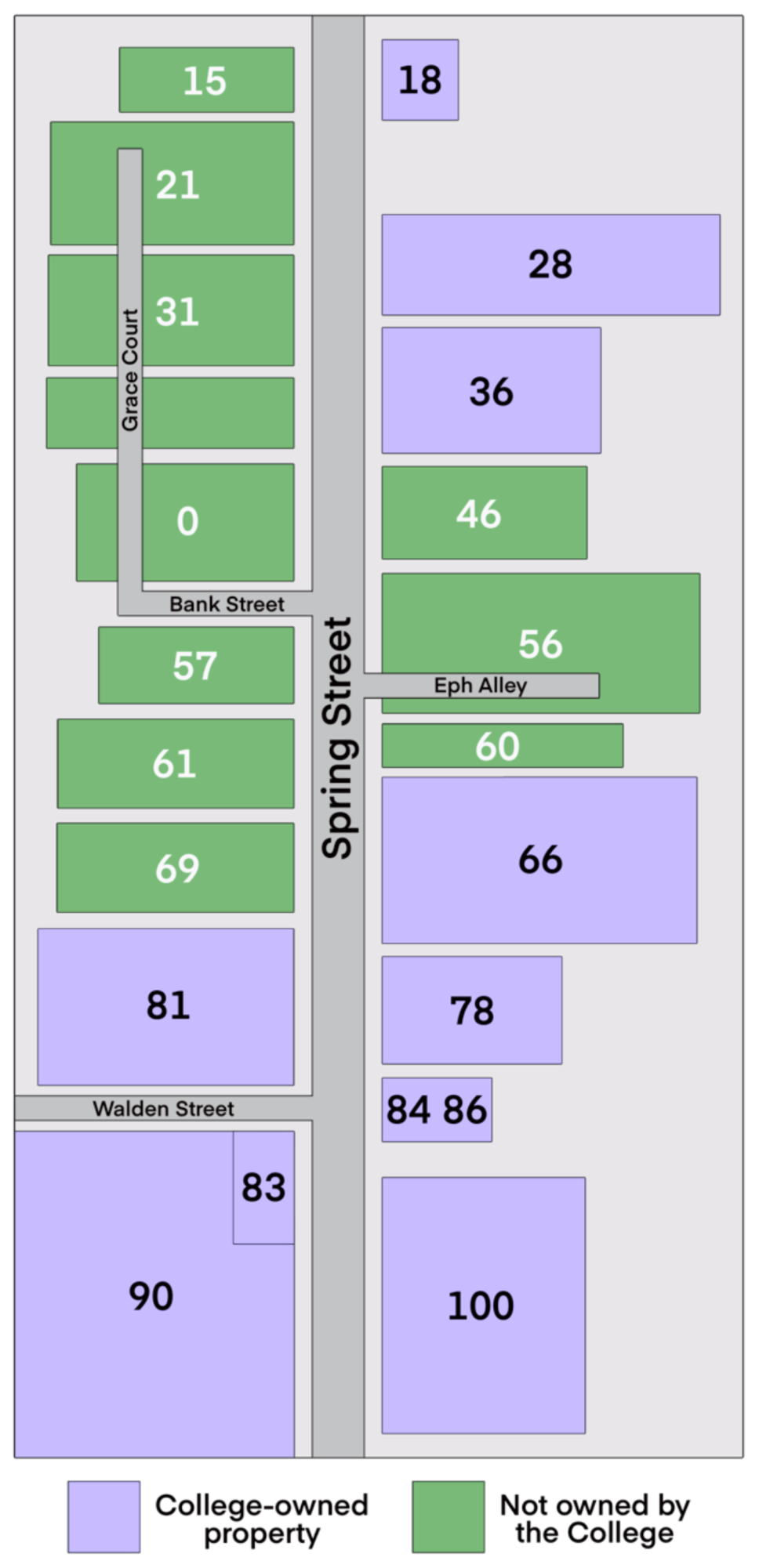
When was the last time you grabbed a sandwich from Spring Street Market? Drank a coffee from Tunnel City? Stopped by ABC Clothing Shop? On languid spring afternoons, students are drawn to Spring Street like moths to a flame, seeking a brief escape from campus or a bite to eat outside of dining hall hours. Yet, it might not be as much of an escape as they imagine — many beloved businesses on Spring Street occupy buildings owned by the College.
The College’s spaces
The College owns nine out of the 20 buildings on Spring Street, each of which host retail spaces that entrepreneurs can lease. “A lot of these buildings serve double duty,” said Associate Provost Chris Winters ’95, who handles the College’s relationships with local businesses. “While they might be commercial on the first floor, what goes unnoticed by most people is the functions that [the buildings] serve above them, and that makes them even more attractive for the College.”
The upper floors of College-owned buildings on Spring Street contain office space used by departments like athletics and human resources, as well as apartments rented to faculty and staff.
“It’s definitely important to note that we don’t own the street,” Winters said as we toured the College’s properties on a sun-soaked afternoon. “We own less than half of it, but it’s a very cooperative ecosystem of a small number of property owners all wanting the best for the street.”
The variety of offerings on Spring Street is no accident, according to Winters. “There are certain things that we really want to see on Spring Street: places for people to get their hair cut — [like the] Clip Shop and barber shop — or Spring Street Market and Pappa Charlie’s for inexpensive, quick, casual food,” he said. “I think it’s fair to say that we do try to put things on the street that people in the broader community, and students key amongst them, will find value in.”
Some buildings like the B&L Building (labeled 100 on the map) — home to Tunnel City Coffee — and Lickety Split (83), were constructed by the College.
Sharon Marceau, the College’s real estate and housing coordinator, remembers when the B&L space held something else entirely. “There was a gas station there when I first started working with the College,” she said. “It was the B&L [service] station. So this is [called] the B&L building,” she added, pointing at the red-and-black structure, which was built in 2005. The service station, a community favorite, closed in 2003 after the property was sold and later donated to the College.
Restoring Spring Street’s history
Other buildings owned by the College have longer histories. The Log, which first opened in 1941, is one such example. “It’s been used for such different things. It was a tea house, and then in the 1940s, the College acquired it as an alumni house, and that lasted for about ten years,” Winters said. “And then … it became a student union of sorts.”
The College has ensured the preservation of the building’s history, despite renovating it several times over the years. During 2015 renovations, the siding and roof were replaced, but the architects kept the older beam structure inside, according to Marceau. These beams are scratched with the marks of past students, including carvings of people’s initials, she added.
The former site of the Williamstown Apothecary, which closed due to financial challenges in November 2024, is now “turnkey-ready” for a new pharmacy, retail space, or small-scale food service, according to Winters. The space, flanked by the Tea and Boba Lounge and Spring Street Market, is one of four in the historic Danforth building (66).
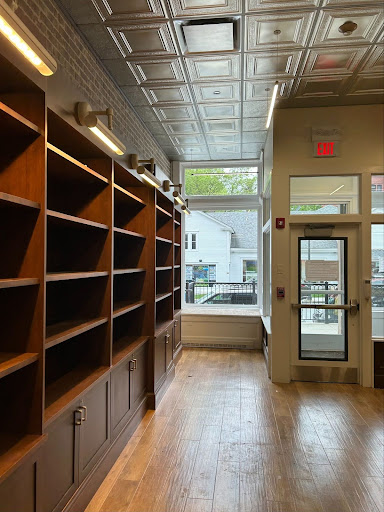
When renovations to the space began in 2019 to prepare for the Apothecary’s arrival, Winters said that the College prioritized maintaining the character of the building. “Whenever we’ve touched these [buildings] in the last ten years, we’ve endeavored to bring back some of these vintage or original features, including tin ceilings and exposed brickwork, to bring back some of the history of the street,” Winters said. As for the space’s future? “It’s built for a pharmacy, and we hope that it becomes a pharmacy again,” Winters said.
Another empty space, the former home of Hart’s Pharmacy and Purple Dragon Games (36), is not quite lease-ready. Upon walking into the space, located next to the Clip Shop, the paper-covered floor and stripped walls make apparent the scale of the renovation underway. “It’s a very old building,” Winters said.
When we toured the basement and saw a yellowed sign urging users to conserve energy, he remarked that “it probably dates from the energy crisis in the Carter administration.”
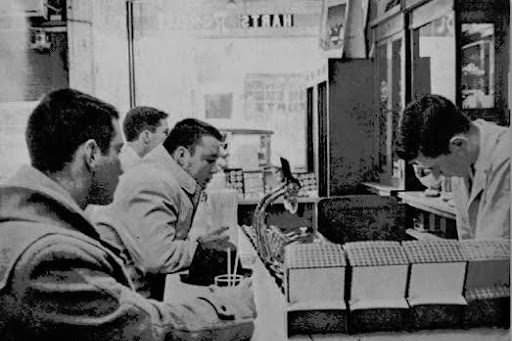
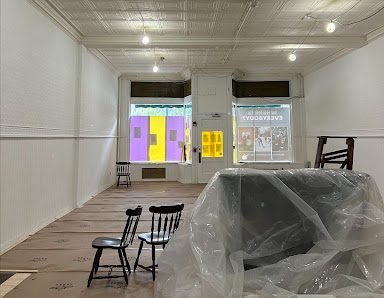
Planned improvements to the space include adding two ADA-compliant bathrooms and improving access to the basement, according to Winters.
Apparently, opportunities to do these sorts of renovations are few and far between. “When these occasions arise where there’s a vacancy, we take the opportunity to make these improvements,” he said. “Otherwise, with a successful business like Hart’s pharmacy, you can go a lifetime [between renovations].”
Relationships with tenants
In addition to renovations between tenants, the College is also careful to attend to any needs that arise for current tenants. Marceau is the main point of contact for business owners who have issues with their spaces and puts them in contact with the College’s team. “Our facilities team is great,” she said. “If [tenants] have a problem with the air conditioning or a leak, they’ll reach out and we’ll make that connection with facilities. They’re very responsive.”
Jamal Stockton, one of the owners of Tunnel City, appreciates the College’s responsiveness to problems that arise. “When you have a larger institution that cares about the community, it’s much better for us, because we can make a call and it’s usually handled within 24 hours,” he said. “The school does a fantastic job.”
For Stockton, another perk of having the College as a landlord: the stability provided by its abundant resources. “The powerful thing of working with [the College] is they have a lot of resources,” Stockton added. “They can keep things much more stable in times of volatility. And so working with [it] has proved to be a good relationship for the business.”
Stress in the street’s ecosystem
The size and scale of the College’s resources exceed those of private property-owners. On occasion, this has become a source of tension on the street. Hugh Daley — who owns the buildings which house Unlimited Nutrition, Chapter Two Books, and Amy’s Cottage — said he feels certain pressures as a local landlord.
“In general, I consider the College a force for good on Spring Street,” he said in an interview with the Record. “There’s always an undercurrent of concern that, since the College doesn’t have the same economic constraints that a guy like me does, they don’t have to charge rent if they don’t want to.”
When asked if the College subsidizes rent for its tenants, Winters said, “The answer is no, with the exception of ABC. That was a decision made right around [the pandemic], I think, in order to help it as a nonprofit with charitable intentions.”
“Otherwise,” he added, “we endeavor that everyone should be paying market rates.”
Daley acknowledged improvements on the College’s end. “I think the College has gotten a lot more disciplined in their real estate [management] in the last 10 years,” he said. “They’ve gotten much better about recognizing that if they set artificially low rents for themselves, they set artificially low rents for the area.”
Private property-owners and the College share the responsibility to preserve harmony on Spring Street. “The ideal ecosystem is everyone pulling for the same outcome, which is the success of those businesses that are providing goods and services to the community that the community wants,” Winters said. “That’s where we want to be.”




